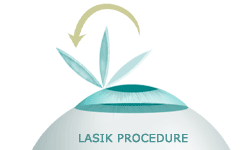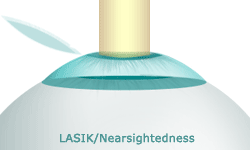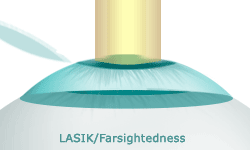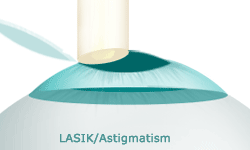Lasik Procedure
 Lasik Procedure:
Lasik Procedure:
LASIK, an acronym for Laser-Assisted In Situ Keratomileusis, is a short procedure that permanently reshapes your cornea using an excimer laser. A small flap in made in your cornea, using a tiny surgical instrument. This flap is then folded over, and the excimer laser fixes the imperfections on your cornea. The flap is replaced, and most patients start seeing clearly almost immediatley!
This revolutionary procedure has been responsible for reducing the dependency on glasses or contacts for millions of people. The goal of BetterVisionCenters.com is to provide you with a little bit of information on the procedure, and help match you with a qualified surgeon to answer your questions, and perhaps...perform the surgery!
 The Lasik Procedure - Step By Step
The Lasik Procedure - Step By Step

An excimer laser takes a detailed map of your eye - a map that will later be programmed into the laser to correct the imperfections. Special eye drops containing anesthesia are placed in each to ensure numbness while undergoing the procedure.
 Step Two
Step Two
A small instrument is sued to keep your eye open. As you recline back in the chair, you will be looking into a small blinking light. Your surgeon will use a microkeratome, or a small surgical instrument to create a flap in your cornea. This place will be no bigger than 1/4 of your entire cornea's depth. The flap-creating process is generaly painless for the patient - much like the entire procedure, and takes no more than 20 seconds.
 Step Three
Step Three
The flap of your cornea is now retracted, and the inner area of your cornea is exposed. The excimer laser emits a beam of light, and using the map created earlier, reshapes the coreanal bed - correcting the vision of the patient.
 Step Four
Step Four
The corneal flap is put back - and automatically attaches itself back into place to act as a bandage for your eye. The instrument holding your eyes open is removed. In only a few minutes, the corneal flap will heal almost completely. This entire process has taken no more than 10 minutes in it's entirety. Moreover, the laser was only exposed to each eye for less than one minute.
You will receive more drops in your eye to maintain moisture. By now, your blinking is probably normal, and a successful patient should start being able to see almost immediately! Your surgeon will probably prescribe moisterizing drops, as your eyes may feel dry for the next few days. A ride home for the patient should be arranged ahead of time, as surgeon do not allow driving any kind of vehicle after the procedure. By now, you should be seeing better than you did with your glasses and contacts!
 How It Works
How It Works
 Nearsightedness:
Nearsightedness:

If you're nearsighted, your cornea will be flatten with the excimer laser. This is done by removing tissue from the center of the cornea.
 Farsightedness
Farsightedness

If you're farsighted, the excimer laser will steepen your central cornea. The laser will remove tissue from the corneal area to acheieve this.
 Astigmatism
Astigmatism

If you have astigmatism, your cornea will be made more spherical. The actual pattern of the excimer laser beam is changed, and tissue is removed from a specified area.

